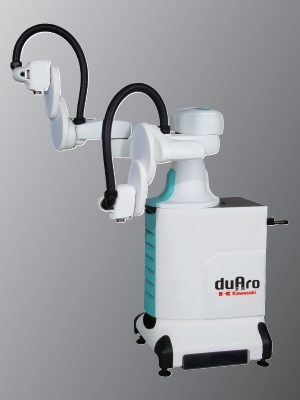
Kawasaki Robotics introduces the duAro2, a dual-arm collaborative SCARA robot with an increased maximum payload capacity and vertical stroke. The new model adds to Kawasaki’s offering of cobots for the Americas, and makes the duAro robot line adaptable to a broader range of manufacturing processes.
The duAro2 robot is equipped with the same innovative qualities of Kawasaki’s original collaborative dual-arm SCARA robot, duAro, with an extended vertical stroke and increased payload. duAro robots are a cost-effective robotic solution for assembly, material handling, inspection, machine tending, packaging and dispensing applications. Their easy teaching functionality and mobile collaborative design make them ideal for short product cycles and frequent changeovers.
While the series’ inaugural duAro1 model specializes in horizontal motion, the duAro2 improves upon its capabilities, extending the range of its arms’ vertical stroke by 400 mm (from 150 to 550 mm) and increasing the maximum payload of its arms by 1 kg per arm (from 2 to 3 kg per arm, 6 kg total).
The wrist assembly has been redesigned, enabling the robot’s arms to fold like a human’s. This linkage design increases the vertical stroke while keeping the overall range of motion compact, and allows duAro2 to be used for an even wider variety of applications such as packaging and rack loading. The new option to detach the duAro2’s arms from the controller further enhance the cobot’s installation versatility, making it adaptable to a wide variety of needs in manufacturing sites, such as installation on conveyors.
For optimal performance, the duAro2 robot runs on one of Kawasaki’s industry-leading F series controllers, which was built specifically for duAro robots. The F61 Controller features options for Bluetooth connectivity, encoder-supported conveyor synchronization, and integrated 2D vision, among others. Previously, the D61 Controller required a separate computer dedicated to image processing in order to utilize the vision functionality. Now, the F61 can handle image processing alone using an optional camera and software, making it a cost-effective and efficient solution.
This controller architecture also allows for more flexible installation options. The controller can be housed inside the duAro2’s slim, wheeled cabinet (integrated installation option) or on its own, connected to the robot through cables (separated installation option). In the separated option, the arms are detached, enabling the use of duAro robots in almost any layout.
Kawasaki’s duAro1 robot is almost identical to the inaugural duAro, the only differences being duAro1 has a decreased cabinet size and operates on the F61 controller as opposed to the D61. The new model will also be available for purchase as separated or integrated for increased installation flexibility.
FEATURES
Increased Vertical Stroke & Payload Capacity
duAro2’s extended vertical stroke (150 to 550 mm) and increased payload (from 2 to kg per arm, 6 kg total) allows the robot to be used for a wider variety of applications.
Installation Flexibility
The slim cart allows for installation in tight spaces. The installation options for integrated or separated controller help duAro2 fit into a variety of layouts.
Innovative Design
The duAro robots, with their two coaxial arms operated by one controller, can fit into a one-person space. In addition providing independent arm operation, the single-axis configuration enables the robots to easily perform coordinated arm movements, much like a human.
Collaborative Operations
Low-power motors, a soft body, speed, force and work zone monitoring, and a deceleration function enable duAro robots to safely collaborate with humans in work operations. In the unlikely event of a collision, the collision detection function instantaneously stops the robot’s movement.
Easy Teaching
The lead-through teach function allows the user to easily teach the robot tasks by hand guiding its arms. Teaching operations can also be conveyed via a tablet which can be connected to multiple robots.
Main Specifications
| Model | duAro2 |
| Launch date – Americas | March 13, 2019 |
| Arm type | Horizontal articulated |
| Degrees of freedom | 4 axes x 2 arms |
| Max. payload | 3 kg x 2 arms |
| Positional repeatability | ±0.05 mm |
| Product weight (separated, integrated) | 100 kg, 210 kg |